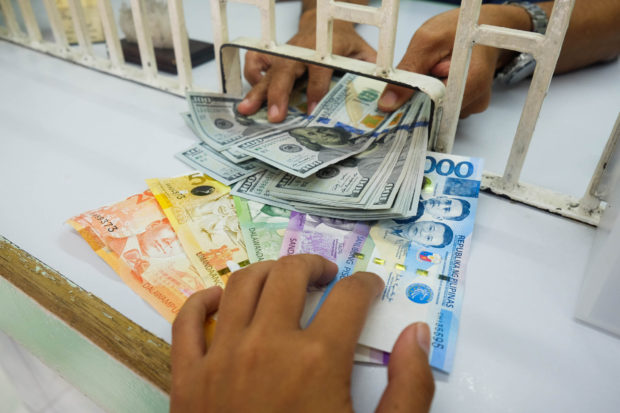MANILA, Philippines — The Philippine peso closed spot trading at 57.48:$1 on Sept. 20, a new all-time low for the seventh time in 13 trading days as policy meetings of monetary authorities here and in the United States draw near.
The local currency wilted even worse at intraday trading, facing off with the US dollar at as weak as 57.50:$1 after opening the day at 57.40:$1, which was the previous day’s closing. Its best showing was 57.355:$1.
The peso lost eight centavos to the greenback compared to Sept. 19, when it enjoyed a brief gain of three centavos from 57.43:$1 on Sept. 16.
Aside from the United States and the Philippines, monetary policy meetings are also scheduled this week in the United Kingdom, Switzerland, Norway, Taiwan and Indonesia.
ING Bank said in a commentary that central banks in all these countries are expected to see interest rates go up, reflecting the strength of the US dollar.
“As usual, most attention will be given to Wednesday evening’s [US Federal Reserve] announcement,” the Dutch bank said. “There seems no reason for the Fed to soften the hawkishness shown at the recent Jackson Hole symposium and a 75bp [0.75 percentage point] ‘hawkish hike’ should keep the dollar near its highs of the year.”
ING Bank was referring to an annual Fed conference that was held last August in Jackson Hole, Wyoming, in which the American central bank signaled that it was ready to continue raising rates to bring down decades-high inflation despite the risk of recession or economic contraction.
Wider deficit
Michael Ricafort, chief economist at Rizal Commercial Banking Corp., said that rising interest rates in the US increases the attractiveness of the US currency with higher income on US dollar deposits, fixed income investments and securities.
Ricafort said that, on Sept. 19, the yield on the benchmark 10-year US Treasury yield reached a new 11-year high of 3.52 percent.
Ricafort said the peso was also weaker after the Bangko Sentral ng Pilipinas (BSP) reported that the country’s balance of payments deficit widened in the January-August period to $5.49 billion this year from $253 million in the same period of 2021.
He added that, on the other hand, global crude oil prices were in their weeklong lows, leading to the latest large decrease in diesel pump prices, by P4.15 per liter, and also potentially lower import bill.
Ricafort said that since trading at 50.999:$1 at the end of 2021, the peso has depreciated by 12.7 percent, losing 6.481 to the US dollar.
RELATED STORIES
Investors turn cautious ahead of BSP policy meeting
Fed officials reluctant to call inflation peak as policy meeting looms


